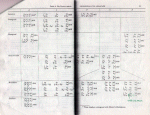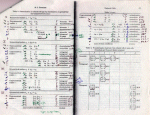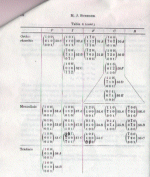Introductory Extract from "'Reduced Cells', M.J. Buerger,
(Zeitschift fur Kristallographie, BD 109, S. 42-60 (1957)"
Abstract
"Several authors have erroneously stated that the endpoint of the Delaunay reduction
is the reduced cell, although Delaunay himself was well ware of the
literature on reduced cells and avoided using the term in connection with his
reduction. The nature of the reduced cell and the cell resulting from the Delaunay
reduction are discussed. There are several reasons for preferring the reduced
cell. The poopularity which the cell resulting from the Delaunay reduction has
achieved appears to be due to the fact that no one has made a point of developing
methods for finding the reduced cell. In this paper, the following three methods of
finding the reduced cell from an arbitrary primitive cell are presented: (1) a
simple graphical methods, (2) an analytical method suitable for digital computers,
and (3) an algorithm which is not only simpler, but which converges to its result
more rapidly than the Delaunay reduction.
Niggli has already prepared the ground for identifying the crystal system
and lattice type from the scalar representation of the reduced cell. Some of
his results are presented in more convenient tabular form.
"
Part of the Introduction
"
A short time ago Ito presented a method by which powder photographs
of crystals of any symmetry can be indexed. His method indexes the
reflections on the basis of an arbitrary primitive cell of the lattice. In
order to interpret the results, this cell must be transformed into some
easily recognised standard cell. Ito chose, as standard, one of four cells
provided by the Delaunay reduction, specificially that cell which is
based on the three shortest axes of the four homogenious axes
corresponding to Delaunay reduced form. In two places, Ito referrred to
this cell as the "reduced cel", and this practise has been copied by
Henry and Lonsdale and by Donnay. This is an unfortunate slip,
since the term "reduced cell" was already well established, and had been
defined in a different way. Delaunay himself was doubtless well
aware of this, for he carefully avoided the suggestion that the end point
of his reduction was a reduced cell. The reduced cell is defined as the
one based upon the tree shorted noncoplanar translations of the lattice.
Its interaxial angles are not restricted to acute or obtuse, and
the cell can belong to either of the two possible types, which can be
described as all-acute and all-obtuse. On the other hand, all cells
corresponding to Delaunay's reduced form are necessarily all-obtuse,
so that in only half the cases does the result of this reduction correspond
to a true reduced cell. an obvious recommendation is that a cell resulting
from a Delaunay reduction should not be called a "reduced cell"
although it might be called a "Delaunay cell".
[text deleted]
One has the impression that the present use of the Delaunay cell
has a purely practical basis in the sense that, if one requires a
standard cell, the Delaunay reduction is known to provide on, whereas no one
has made an issue of how to find the reduced cell. Actaully, it is a
straightforward matter to find the reduced cell, and in most cases it can
be found more easily and quickly than the Delaunay cell can be found
by the Delaunay reduction.
"
Nature of the Problem
(Refer "'Reduced Cells', M.J. Buerger,
(Zeitschift fur Kristallographie, BD 109, S. 42-60 (1957)")
Graphical method of finding the reduced cell
(Refer "'Reduced Cells', M.J. Buerger,
(Zeitschift fur Kristallographie, BD 109, S. 42-60 (1957)")
Search for shortest translations by trial computations
(Refer "'Reduced Cells', M.J. Buerger,
(Zeitschift fur Kristallographie, BD 109, S. 42-60 (1957)")
An algorithm for finding the reduced cell
(Refer "'Reduced Cells', M.J. Buerger,
(Zeitschift fur Kristallographie, BD 109, S. 42-60 (1957)")
|


